Abstract
The demand for high-performance polypropylene (PP) films in high-end packaging applications has been growing rapidly. However, Traditional polypropylene (PP) films are limited in application by their inadequate mechanical strength, heat-sealing performance, and matte properties. Hence, in this study, styrene-butadiene copolymer-modified polypropylene (PP) matte films using styrene-butadiene copolymer (SB) as a modifier were successfully prepared. A comprehensive characterization of the films’ optical, mechanical, thermal, and processing properties was conducted using specialized instrumentation. Capillary rheometry revealed that the melt viscosity of the PP/SB blends decreased with increasing shear rate, demonstrating typical pseudoplastic behavior. Differential scanning calorimetry (DSC) showed single melting and crystallization peaks, indicating excellent compatibility between PP and SB. The optimal performance was achieved with 7.00 wt% SB, resulting in a film with a light transmittance of 92.08%, a haze of 66.40%, and a gloss of 3.63 GU. This formulation also yielded more uniform tensile strength and elongation in both longitudinal and transverse directions, and reduced the heat-sealing temperature to 101 °C, significantly lower than the 111 °C required for pure PP. Overall, the SB-modified PP films exhibited excellent mechanical strength, enhanced heat sealability, and superior matte properties, highlighting their significant potential for high-end packaging applications.
1. Introduction
Cast polypropylene film, abbreviated as CPP film, is a type of polypropylene (PP) film fabricated through a casting process with polypropylene (PP) as the raw material. It is extensively employed as a packaging material for many goods such as food, textiles, daily necessities, and electronic products [,,]. Nowadays, with the growing demand for high-end packaging materials that offer soft and esthetically pleasing visual effects, CPP films with high haze, high transparency, and low gloss have become a research focus. The films are typically produced by adding inorganic extinction powders (such as silicon dioxide, calcium carbonate, and talc) or through resin blending modifications; by which, however, the performance of the films produced as such is often compromised in terms of transmittance, appearance, and mechanical properties [,,,,]. Therefore, exploring alternatives to the abovementioned conventional methods for the production of CPP films with desirable optical and mechanical properties is of significant importance.
As set forth, one of the conventional methods for preparing CPP extinction films involves adding certain inorganic powders to enhance the film’s extinction characteristics by exploiting the refractive index differences and light scattering properties [,,]. However, this approach often leads to reduced transmittance and degraded mechanical properties of the fabricated films. Alternatively, resin blending modification has also gained popularity [,,,,], which leverages the distinct refractive indices and crystallization behaviors of two different resins to form minute phase regions on the film surface, enhancing light absorption through multiple refractions and surface reflections in the minute phase regions. For example, Boyda et al. [] found that PP/PE (polyethylene) blends exhibited lower light absorption density and improved optical stability compared with pure PP. Luo et al. [] demonstrated that incorporating ethylene vinyl acetate (EVA) into PP increased haze and transmittance, with optimal effects at 30% EVA content. Chen X Y, et al. [] reported that a 50/50 PP/PE blend achieved exceptional properties of high haze, low gloss, and high transmittance, highlighting its potential for high-end packaging. Chen X W, et al. [] further elucidated the mechanisms governing surface roughness in PP-PE matte films, revealing that static crystallization plays a key role in texture formation. All these findings indicate that modifying PP by blending with appropriate polymers can significantly improve the optical properties of CPP films. However, research on using thermoplastic elastomers like styrene-butadiene copolymer (SB) for such modifications remains limited. This gap presents an opportunity to explore SB as a modifier to achieve high-performance CPP matte films with enhanced haze, mechanical properties, and heat-sealing characteristics.
SB is a thermoplastic elastomer known for its good compatibility with PP and is commonly used to improve the impact resistance and low-temperature toughness of PP through blending. Despite its being widely used as a toughening agent, the potential of SB in modifying the optical properties of CPP films remains largely unexplored. Therefore, in this study, SB was employed as a modifier for the production of CPP matte films by blending with PP. The as-prepared films were then comprehensively evaluated through tests on mechanical, optical, frictional, and heat-sealing properties, and as expected, SB-modified cast films exhibited excellent properties of high haze, high transmittance, low gloss, and a fine matte surface, demonstrating the influence of SB on CPP films, which provides insights for the development of high-performance CPP matte films, and indicating great potential of the films for high-end packaging applications.
2. Materials and Sample Preparation
2.1. Materials
Ethylene propylene butene ternary copolymer (PP), F4908, with a melt index of 7.50 g/10 min at 2.16 kg and 230 °C, was supplied by Sinopec Maoming Petrochemical Co., Ltd.(MaoMing, GuangDong, China); Styrene-butadiene copolymer (SB), SL803G, with a melt mass flow rate (MFR) of 8.20 g/10 min at 5.00 kg and 200 °C, was provided by Guangdong Zhonghe Chemical Plastic Co., Ltd. (Maoming, Guangdong, China)
2.2. Sample Preparation
Firstly, PP was thoroughly mixed with 1.00, 3.00, 5.00, and 7.00 wt% SB in a high-speed mixer (BP-GH-10L, Baopin Precision Instrument Co., Ltd. Dongguan, Guangdong, China). Secondly, the PP/SB mixtures in Step 1 were melt-mixed and extruded in a twin-screw extruder (SHJ-20, Nanjing Giant Machinery Co., Ltd. Nanjing, China) at 160 to 210 °C and 40 rpm (Hz = n(rpm)/60) to obtain PP/SB blends. Finally, the PP/SB blends were processed into 0.05 mm thick PP/SB matte films by means of a casting machine (XH-432-25, Guangdong Xihua Machinery Co., Ltd. Dongguan, Guangdong, China) at 160 to 230 °C.
3. Characterization/Testing Methods
3.1. Rheological Properties
The apparent viscosity of the PP/SB blends was evaluated as a function of shear rate using a capillary rheometer (model RTOI06/02, POTOP Co., Ltd. Guangdong, China). A sample of 300–500 g was loaded and tested at 230 °C. Measurements were conducted at rotational speeds ranging from 5 to 40 rpm in 5 rpm increments, with a constant dwell time of 120 s at each speed.
3.2. Crystallization Behavior
According to GB/T19466.1-2004 (Plastics—Differential scanning calorimetry(DSC)-Part 1: General principles. Sac, 2004, China), 3–5 mg of the PP/SB blends was cut and placed into an aluminum crucible to determine the crystallization and melting curves, using a differential scanning calorimeter (DSC25, TA Instruments Ltd., New Castle County, DE, USA). At first, the temperature was ramped up at a rate of 20 °C/min to 200 °C and held for 10 min to eliminate the thermal history in a nitrogen environment. Subsequently, the temperature was ramped down at a rate of 10 °C/min to 40 °C to record the crystallization curve. Eventually, the temperature was ramped up again at a rate of 10 °C/min to 200 °C to record the melting curve.
The calculation formula for crystallinity is presented as follows []:
where is the crystallinity, is the melting enthalpy, is the melting enthalpy when the crystallinity of PP is 100%, which is 209 J/g [].
3.3. Optical Performance Characterization
The optical properties of PP/SB matte films were characterized as follows. Transmittance and haze were measured in accordance with GB/T 2410-2008 (Determination of the luminous transmittance and haze of transparent plastics. Sac, 2008, China), using an SGW-810 photoelectric haze meter (SGW-820, Shanghai INESA Physical-Optics Instrument Co., Ltd., Shanghai, China) with a C light source. Glossiness at 20° was determined according to GB/T 8807-1988 (Test method for specular gloss of plastics. Sac, 1988, China) using a Novo-Gloss Trio gloss meter (IQ 20/60/85, Rhopoint Instruments Ltd., East Sussex, UK). Additionally, the light transmittance across the wavelength range of 400–900 nm was tested with a BSHCE fiber-optic spectrometer (BSHP, Dongguan Baisi Optoelectronic Technology Co., Ltd., Dongguan, Guangdong, China). All measurements were performed seven times on specially prepared specimens (50 mm × 50 mm × 0.05 mm) that were flat, free of breakage, and without obvious defects, under controlled environmental conditions of 25 °C and 40.0% relative humidity, and the average value was taken.
3.4. Mechanical Performance Testing
The mechanical properties of PP/SB matte films were characterized according to the respective Chinese national standards. Tensile properties (strength and elongation at break) were measured following GB/T 1040.3-2006 (Plastics-Determination of tensile properties-Part 3: Test conditions for films and sheets. Sac, 2006, China) using a universal testing machine, with Type 2 specimens tested at a speed of 200 mm/min. Puncture strength was determined as per GB/T 37841-2019 (Test method for puncture resistance of plastic film and sheeting. Sac, 2019, China) on the same machine, using 100 mm × 100 mm specimens. Falling dart impact strength was evaluated based on GB/T 9639.1-2008 (Plastics film and sheeting-Determination of impact resistance by the free-falling dart methord-Part 1: Staircase methords. Sac, 2008, China), employing 200 mm × 200 mm specimens. All specimens, with a uniform thickness of 0.05 mm, were confirmed to be flat, undamaged, and free of visible defects. All tests were repeated seven times in a controlled environment at 23 °C, and the average value was taken.
3.5. Micromorphological Observations
The sample of each PP/SB matte film was first cryo-fractured in liquid nitrogen, and then the cross-section was subjected to gold spraying treatment before observation using the scanning electron microscope (EM-30 Plus, COXEM Co., Ltd., Daejeon, Republic of Korea)
3.6. Heat-Sealing Properties
The heat-sealing properties of the PP/SB matte films were evaluated according to GB/T 34445-2017 (Test method of hot-tack property for heat sealing surfaces of thermoplastic polymer and thermoplastic composite material. Sac, 2017, China) using a five-point heat seal tester (GHS-03, Labthink Co., Ltd., Jinan, China). The tests were conducted under the following standardized parameters: a sealing pressure of 0.3 MPa, a sealing time of 1.0 s, and a lower sealing knife temperature of 90 °C.
4. Results and Discussion
4.1. Processing Properties
The melt viscosities of the PP/SB blends exhibited a gradual decrease with increasing shear rate, demonstrating significant shear-thinning behavior (Figure 1a). This trend aligns with the characteristic rheology of pseudoplastic fluids, indicating that the fundamental pseudoplastic nature of polypropylene was preserved despite the SB incorporation. Furthermore, the apparent viscosity of the blends showed an inverse correlation with SB content at a constant screw speed(ω). Specifically, at a screw speed of 0.50 r·s−1, the apparent viscosities for blends containing 1.00, 3.00, 5.00, and 7.00 wt% SB were 322.3 ± 0.24, 305.6 ± 0.0.25, 307.4 ± 0.22, and 298.0 ± 0.23 Pa·s, respectively. These values correspond to sequential reductions of 2.83%, 7.87%, 7.33%, and 10.16% compared to pure PP, i.e., 331.7 (Figure 1b). This phenomenon was likely attributed to the SB component, which weakened the intermolecular forces and reduced chain entanglements within the polypropylene matrix, thereby effectively lowering the melt viscosity.
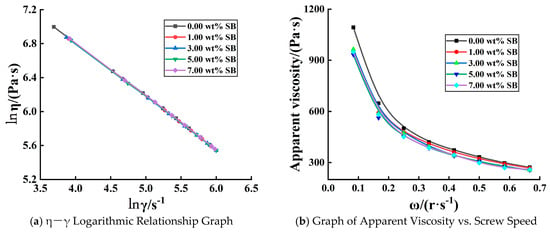
Figure 1.
The processing properties of PP/SB blends.
4.2. Crystallization and Melting Behaviors
The PP/SB blends exhibited a single melting peak and crystallization peak due to the presence of butadiene chain segments in both SB and PP, indicating good compatibility between SB and PP during blending (Figure 2a). Additionally, with increase in the SB content, the crystallization temperature (Tc) of the PP/SB blends remained largely unchanged (Figure 2b), while the crystallinity (Xc) displayed a trend of decreasing at first and then increasing (Table 1). Specifically, as detailed in Table 1, the PP/SB blend containing 3.00 wt% SB showed the lowest crystallinity of at 28.42 ± 0.03%, which was 2.64% lower than that of pure PP, i.e., 31.06 ± 0.03%; and the maximum crystallinity of 31.45 ± 0.02%, which was 0.39% higher than that of pure PP, was achieved by the PP/SB blend with 7.00 wt% SB. The crystallinity of the PP/SB blends exhibited a distinct V-shaped trend, initially decreasing and then increasing with higher SB content. This trend was attributed to a shift in the dominant mechanism. At SB contents below 3.00 wt%, the disruption of PP chain regularity by the butadiene and styrene segments prevailed, reducing crystallinity. Conversely, above 3.00 wt% SB, its own strong crystallization ability and the nucleating effect of the benzene rings became dominant. This promoting effect eventually surpassed the disruptive effect, leading to an increase in overall crystallinity. In short, SB initially disrupted PP chain regularity, reducing crystallinity, but its intrinsic crystallization ability contributed to a subsequent increase at higher contents.
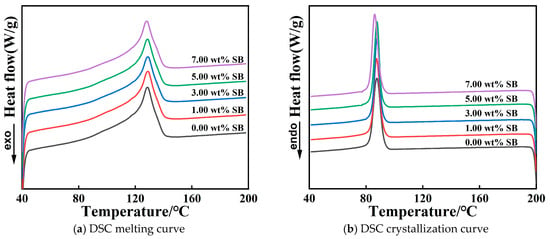
Figure 2.
The melt crystallization behavior of PP/SB blends.

Table 1.
The DSC thermodynamic data of PP and PP/SB blends.
4.3. Optical Properties
Figure 3a,b illustrates the optical properties of the PP/SB matte films, from which it was clear that as the SB content increases, the transmittance and haze of the PP/SB matte films rose progressively, while the gloss decreased gradually. Specifically, when the SB content was 5.00 wt%, the transmittance, haze, and gloss of the PP/SB matte film were 92.05%, 54.39%, and 6.91%, respectively, for the PP/SB matte film containing 7.00 wt% SB, the transmittance, haze, and gloss were 92.08%, 66.40%, and 3.63%, respectively, representing absolute increases of 0.68% in transmittance and 64.29% in haze, and an absolute decrease of 63.18% in gloss, compared with pure PP film, demonstrating superior extinction properties. The optical fiber spectrometer was used to test the light transmittance of the films (Figure 3c), and the results showed that the light transmittance of the films gradually decreased between the light wavelength of 550 nm and 750 nm with the increase in the mass fraction of SB. Combined with the schematic diagram of light transmission through the film in Figure 3d, the explanation was that the added SB presents in the form of dispersed phase SB and was uniformly distributed within the PP continuous phase in PP/SB blends to act as scattering particles, inducing the Rayleigh scattering effect to enhance haze and light transmittance while reducing the gloss. Additionally, the refractive index of PP was 1.493 [], whereas that of SB was 1.574 [], and such a difference in refractive index further contributed to the increased haze and light transmittance and decreased gloss of the PP/SB extinction film.
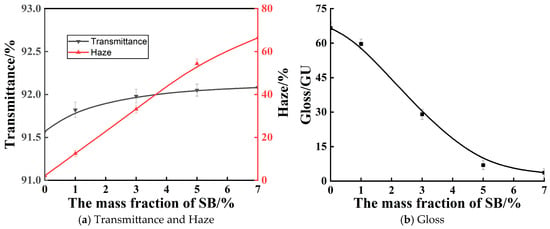
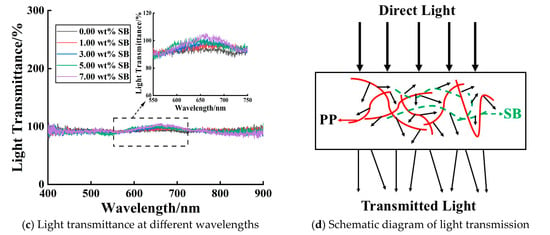
Figure 3.
The optical properties of PP/SB matte films.
4.4. Mechanical Properties
According to the data detailed in Table 2, as the content of SB increases, all the dart impact strength, puncture strength, and longitudinal and transverse elongation at break of PP/SB matte films exhibited a trend of gradually ascending, while the longitudinal and transverse tensile strength gradually declined. Furthermore, with the increase in SB content, the disparity of tensile strength and elongation at break between machine direction (MD) and transverse direction (TD) showed an overall trend of reduction, suggesting that the anisotropy of the mechanical properties of the PP/SB matte films has been ameliorated to present better longitudinal and transverse mechanical homogeneity. In addition, the low values of standard deviation in the mechanical property tests confirmed the excellent reproducibility of the tests. In contrast, the relatively higher variation in elongation at break can be attributed to the inherent characteristics of the tensile test itself and the microstructural heterogeneity of the PP/SB matte films. In practical terms, the longitudinal and transverse tensile strengths and elongation at break of pure PP film differed by 3.72 MPa and 155.81%, respectively. However, for the PP/SB matte film containing 5.00 wt% SB, the differences in tensile strength and elongation at break between the two directions were 1.09 MPa and 23.11%, respectively, and such differences were 0.90 MPa and 35.41%, respectively, for the PP/SB matte film containing 7.00 wt% SB. PP/SB matte films showed improved mechanical uniformity in MD and TD compared with pure PP, enabling the PP/SB matte film to have a significant enhancement in dart impact strength and puncture resistance.

Table 2.
The mechanical property data of PP/SB matte films.
4.5. Observation on Microstructure
According to Figure 4, the cross-sectional microstructure of pure PP (Figure 4a) manifested typical brittle fracture traits, while the PP/SB blends (Figure 4b–e) presented a microstructure dominated by ductile fracture, accompanied by characteristic “dimples”. Figure 4b–e indicated that, with increasing SB content, the size of the dimples in the PP/SB blends distinctly and gradually increased, accompanied by the formation of crazing networks and multiple shear bands, resulting in a concentration-dependent enhancement of the material’s ductile fracture characteristics. This phenomenon was attributed to SB as a styrene-based elastomer, which enjoyed excellent compatibility with the PP matrix and was capable of forming a uniformly dispersed phase during the melt blending process []. Under the action of external loading, SB particles served as stress concentration points, inducing the formation of a three-dimensional crazing system in the matrix through plastic deformation and simultaneously activating the formation mechanism of multiple shear bands. This crazing-shear band synergistic toughening effect, via the energy dissipation of the “dimples” structure, effectively inhibited crack propagation behavior and significantly enhanced the impact toughness of the PP/SB blends [].
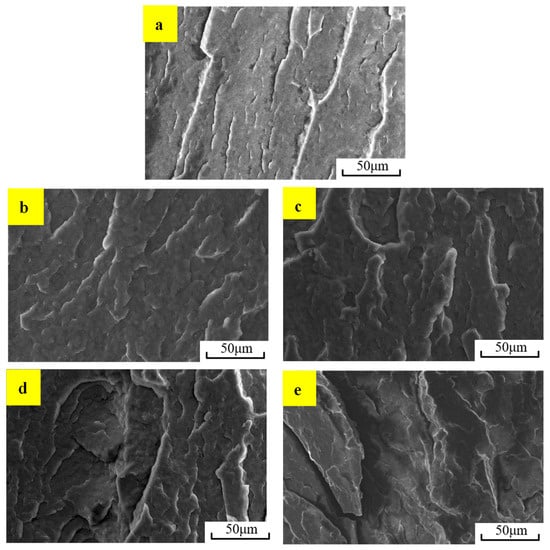
Figure 4.
Observation of the Microscopic Cross-Sectional Structure of PP/SB Blends. (a) PP, (b) PP/SB blends (1.00 wt% SB), (c) PP/SB blends (3.00 wt% SB), (d) PP/SB blends (5.00 wt% SB), (e) PP/SB blends (7.00 wt% SB).
4.6. Heat-Sealing Performance
As shown in Figure 5, the initial, sealing, and ultimate sealing temperatures of the PP/SB matte films decreased noticeably with increasing SB content, demonstrating excellent low-temperature heat-sealability. For the film with 7.00 wt% SB, these temperatures were 101.0 °C, 105.0 °C, and 112.0 °C, respectively—each approximately 10.0 °C lower than those of pure PP. Moreover, the heat-sealing strength stabilized when the temperature reached 112.0 °C or above. This behavior was attributed to the SB component, which softened prematurely upon heating, permeated the sealing interface, and formed a robust bonding layer through mutual melting and mechanical interlocking, thereby effectively lowering the sealing temperature and improving overall performance.
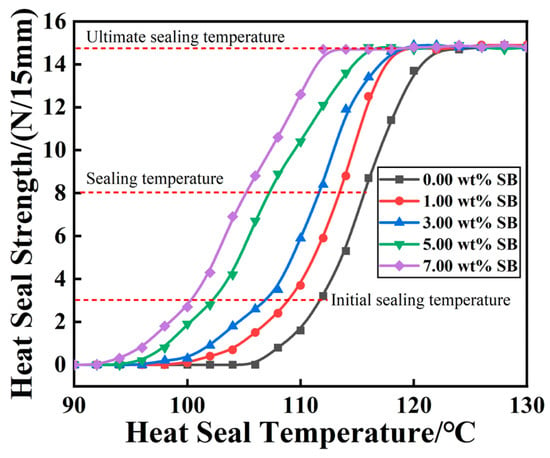
Figure 5.
The Heat Sealing Performance of PP/SB matte films.
5. Conclusions
In this study, various PP matte films were prepared via the cast film process by blending styrene-butadiene copolymer (SB) at different mass fractions with polypropylene (PP). The resulting films were then comprehensively evaluated for their optical, mechanical, heat-sealing, and processing properties. The PP/SB blends demonstrated excellent compatibility, indicated by single melting/crystallization peaks in DSC, and exhibited characteristic pseudoplastic behavior. The incorporation of 5.00–7.00 wt% SB notably enhanced key mechanical properties—tensile strength, puncture resistance, and impact strength—while also reducing anisotropy. Furthermore, the transmittance, haze, gloss, and initial sealing temperature of the as-prepared PP/SB film with 7.00 wt% SB were characterized as 92.08%, 66.40%, 3.63 GU, and 101.0 °C, respectively. These properties collectively endow the film with a high-transparency, high-haze, low-gloss optical profile, coupled with excellent low-temperature heat sealability, making it highly promising for high-end packaging applications.
Future work will focus on investigating the effects of higher SB contents on the comprehensive properties of PP and exploring other potential application areas for these advanced materials.
Author Contributions
K.Y. and J.-L.L.: designed and performed the experiments; K.Y., Y.-L.M., J.-H.W. and Z.Y.: data curation and formal analysis; K.Y.: writing—original draft; S.Z.: writing—review and editing; X.-X.H.: funding acquisition and investigation. All authors have read and agreed to the published version of the manuscript.
Funding
This work was supported by Guizhou Provincial Basic Research Program (Natural Science) (No. QianKeHe Basic-(2024) Youth 373) and Guizhou Provincial Substantial Special Project Program (Outcome Transformation) (No. QianKeHe Outcome-(2024) substantial 002).
Institutional Review Board Statement
Not applicable.
Data Availability Statement
The original contributions presented in this study are included in the article. Further inquiries can be directed to the corresponding authors.
Acknowledgments
I would like to express my gratitude to all those who have helped me during the writing of this thesis. I am truly grateful to the corresponding author, Shu Zeng, and Xiaoxiao Huang for their assistance. Additionally, I would like to thank the learning platform provided by the Guizhou Institute of Metallurgy and Chemical Engineering. Finally, I would like to express my gratitude to the editors of the Journal of Composites Science for their assistance.
Conflicts of Interest
Author Kang Yang, Yu-Long Ma, Zhang Yi, Shu Zeng, and Ju-Heng Wang were employed by the company Guizhou Institute of Metallurgy and Chemical Engineering. Author Jin-Long Lv and Xiao-Xiao Huang were employed by the company Guizhou Nanomaterials Engineering Center. The remaining declare that the research was conducted in the absence of any commercial or financial relationships that could be construed as a potential conflict of interest.
References
- Li, M.W. Research on the Technology and Market of Cast Polypropylene (CPP) Matte Film for Chinese Household Paper. Plast. Plast. 2023, 33, 1–5. [Google Scholar]
- Ping, W. Performance of Polypropylene Cast Film and Development Status of Special Materials. Chem. Pharm. Eng. 2023, 44, 67–70. [Google Scholar]
- Dziadowiec, D.; Matykiewicz, D.; Szostak, M.; Andrzejewski, J. Overview of the Cast Polyolefin Film Extrusion Technology for Multi-Layer Packaging Applications. Materials 2023, 16, 1071. [Google Scholar] [CrossRef] [PubMed]
- Ambroise, B.; Sheppard, R.M.; H Tt, D.; Marchal, A.; Guillaume, C. Co-Extruded, Biaxially Oriented, Matte, Hdpe Films. EP3986713A1, 27 April 2022. [Google Scholar]
- Gahleitner, M.; Paulik, C. Polypropylene and other polyolefins. In Brydson’s Plastics Materials; Butterworth-Heinemann: Oxford, UK, 2017; pp. 279–309. [Google Scholar]
- Lee, W.; Kim, K.; Seo, H.; Park, Y.; Won, J.; Kang, H. Effect of different polyolefin film haze rates on cultivation environment and lettuce growth. J. Agric. Life Environ. Sci. 2022, 34, 264–273. [Google Scholar]
- Maddah, H.A. Polypropylene as a promising plastic: A review. Am. J. Polym. Sci. 2016, 6, 1–11. [Google Scholar]
- Gillis, G.G. Multilayer Matte Biaxially Oriented Polypropylene Film with Ultra Low Seal Initiation Temperature. U.S. Patent 10,022,941(P), 17 July 2018. [Google Scholar]
- Ammar, L.B.; Fakhfakh, S. Optical and dielectric properties of polypropylene/montmorillonite nanocomposites. Funct. Compos. Struct. 2020, 2, 045003. [Google Scholar] [CrossRef]
- Kloziński, A.; Szczepańska, M.; Jakubowska, P.; Samujło, B.; Barczewski, M.; Lota, G. The influence of calcium carbonate and its modifications on the extrusion process and selected functional properties of polypropylene cast films. Polimery 2022, 67, 509–521. [Google Scholar] [CrossRef]
- Ramazanov, M.A.; Shirinova, H.A.; Nuriyeva, S.G.; Jafarov, M.A.; Hasanova, M.R. Structure and optic properties of the nanocomposites based on polypropylene and amorphous silica nanoparticles. J. Thermoplast. Compos. Mater. 2023, 36, 1762–1774. [Google Scholar] [CrossRef]
- Li, L.; Chen, L.; Bruin, P.; Winnik, M.A. Morphology evolution and location of ethylene–propylene copolymer in annealed polyethylene/polypropylene blends. J. Polym. Sci. Part B Polym. Phys. 2015, 35, 979–991. [Google Scholar] [CrossRef]
- Chen, X.; Yu, P.; Kostromin, S.; Bronnikov, S. Minor-phase particles evolution in a polyethylene/ethylene–propylene copolymer (80/20) blend across mixing: Breakup and coalescence. J. Appl. Polym. Sci. 2014, 130, 3421–3431. [Google Scholar] [CrossRef]
- Elkoun, S.; Huneault, M.; McCormick, K.; Puterbaugh, F.; Kale, L. LLDPE-based mono- and multilayer blown films: Effect of processing parameters on properties. Polym. Eng. Sci. 2010, 45, 1214–1221. [Google Scholar] [CrossRef]
- Johnson, M.B.; Wilkes, G.L.; Sukhadia, A.M.; Rohlfing, D.C. Optical properties of blown and cast polyethylene films: Surface versus bulk structural considerations. J. Appl. Polym. Sci. 2000, 77, 2845–2864. [Google Scholar] [CrossRef]
- Liao, T.C.; Chen, C.L.; Wu, W.Y. Matte Synthetic Paper. US10774206B2, 23 April 2020. [Google Scholar]
- Boydağ, F.Ş.; Mamedov, S.V.; Alekperov, V.A.; Özcanli, Y.L. Optical characterization of weakly absorbing PP, PE, and PP/PE films. Opt. Spectrosc. 2003, 95, 225–229. [Google Scholar] [CrossRef]
- Luo, S.; Yi, P.; Xiong, Y.; Shen, J.; Guo, S. Light-scattering capacity of ethylene–vinyl acetate copolymers in polypropylene: Toward high haze and transmittance. J. Appl. Polym. Sci. 2016, 133. [Google Scholar] [CrossRef]
- Chen, X.Y.; Xiang, M. Formulating of a novel polyolefin hazy film and the origins of haze thereof. Polym. Bull. 2010, 64, 925–937. [Google Scholar] [CrossRef]
- Chen, X.W.; Chen, S.T.; Meng, L.W. Mechanism of woven structure formation in polypropylene polyethylene extinction film system. Polym. Mater. Sci. Eng. 2019, 35, 13–19. [Google Scholar]
- Gray, A.P. Polymer crystallinity determinations by DSC. Thermochim. Acta 1970, 1, 563–579. [Google Scholar] [CrossRef]
- Scoti, M.; De Stefano, F.; Di Girolamo, R.; Malafronte, A.; Talarico, G.; De Rosa, C. Model of Crystallization Behavior of Isotactic Polypropylene: The Role of Defects. Macromol. Chem. Phys. 2023, 224, 2200262. [Google Scholar] [CrossRef]
- Addeo, A. Polypropylene Handbook; Hanser: Munich, Germany, 2005. [Google Scholar]
- Henderson, J.N. Styrene-butadiene rubbers In Rubber Technology; Boston, MA: Springer US: Boston, MA, USA, 1987; pp. 209–234. [Google Scholar]
- Wypych, G. Handbook of Polymers; Elsevier: Amsterdam, The Netherlands, 2022. [Google Scholar]
- Jang, B.Z.; Uhlmann, D.R.; Sande, J.B.V. Rubber-toughening in polypropylene. J. Appl. Polym. Sci. 1985, 30, 2485–2504. [Google Scholar] [CrossRef]
Disclaimer/Publisher’s Note: The statements, opinions and data contained in all publications are solely those of the individual author(s) and contributor(s) and not of MDPI and/or the editor(s). MDPI and/or the editor(s) disclaim responsibility for any injury to people or property resulting from any ideas, methods, instructions or products referred to in the content. |
© 2025 by the authors. Licensee MDPI, Basel, Switzerland. This article is an open access article distributed under the terms and conditions of the Creative Commons Attribution (CC BY) license (https://creativecommons.org/licenses/by/4.0/).